Physical Address
304 North Cardinal St.
Dorchester Center, MA 02124
Physical Address
304 North Cardinal St.
Dorchester Center, MA 02124
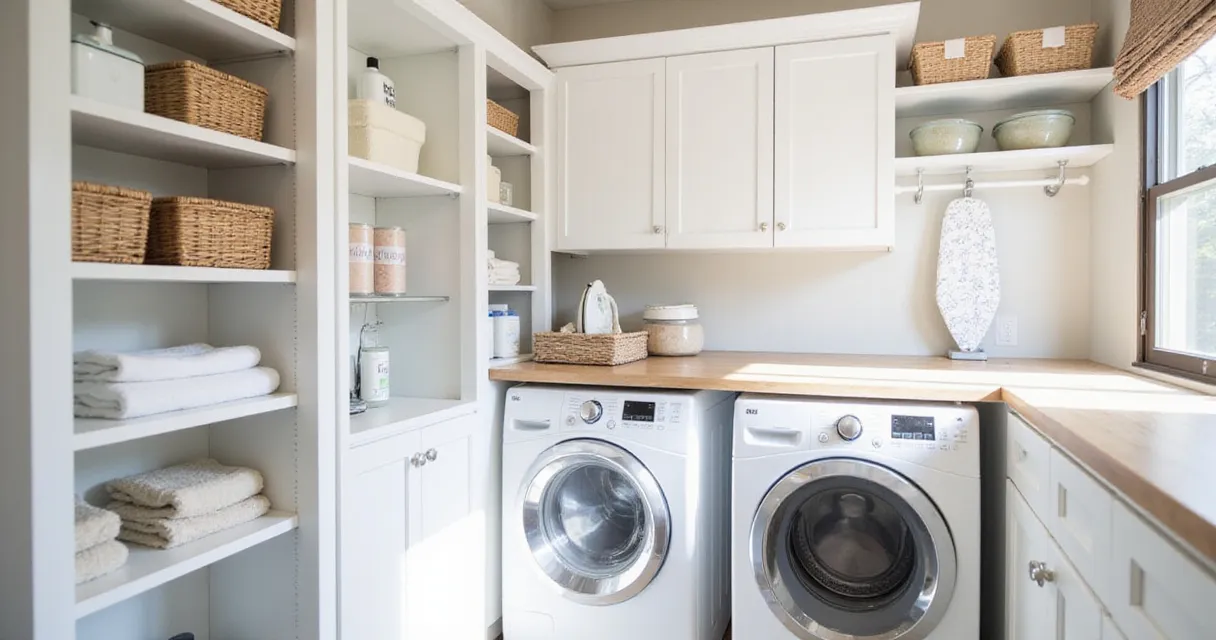
Discover 19 genius laundry room design ideas to transform your space from functional to fabulous. From smart storage solutions to stylish decor, create a laundry room you'll love.
Let’s face it, the laundry room is often the forgotten stepchild of home design. It’s the place where chaos reigns supreme, socks go missing, and the hum of the dryer is the soundtrack to your chores. But what if your laundry room could be more than just a functional space? Imagine a laundry room that not only streamlines your chores but also adds a touch of style and serenity to your daily routine.
Ready to ditch the drab and embrace the fab? Then dive into these 19 genius laundry room design ideas that will transform your space from a chore-filled dungeon to a haven of fresh-smelling, folded perfection.
Laundry rooms, more often than not, are squeezed into the nooks and crannies of our homes, leaving us battling for every inch of usable space. The answer lies in thinking upwards – embracing Vertical storage. This simple shift dramatically changes the room’s feel, making it appear larger, more organized, and ultimately, more efficient. Plus, keeping your laundry essentials within easy reach means less bending and stretching, making laundry day just a little bit easier on your back.
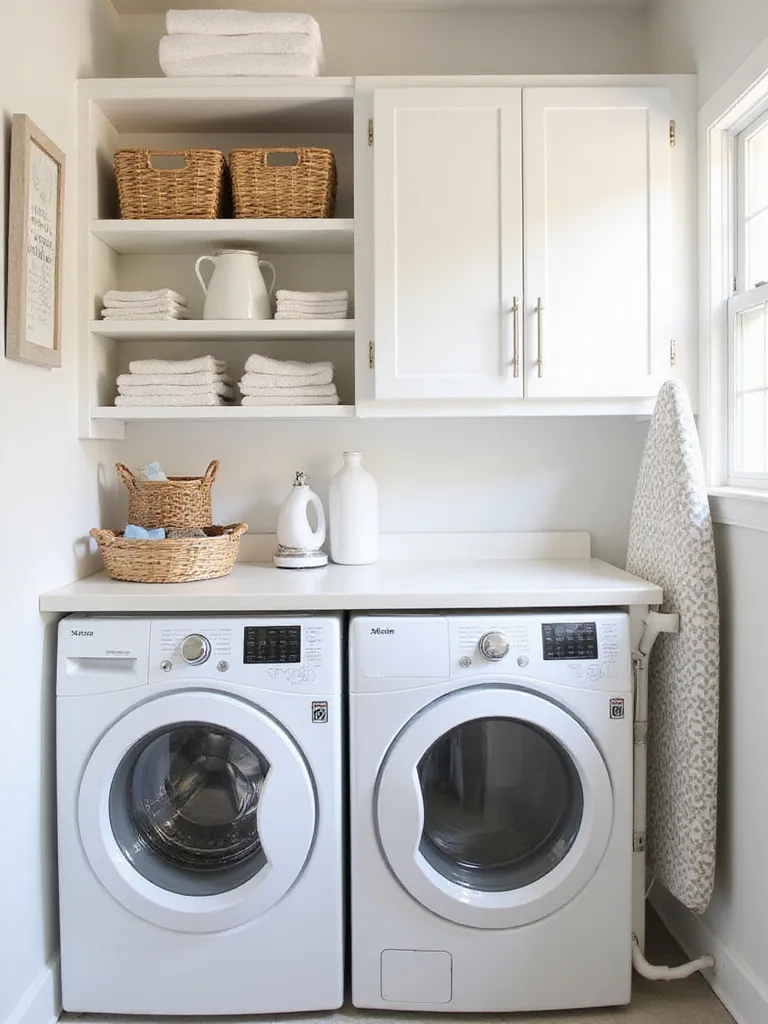
When planning your vertical storage strategy, consider these key elements:
Here’s where it gets interesting: the average washing machine is around 39 inches tall, leaving a significant amount of unused vertical space above it. Measure your laundry room space carefully before purchasing any storage solutions to make the most of every available inch.
Sorting, folding, and ironing – these are the tasks that often lead to laundry room chaos. The solution? A dedicated folding counter. When not in use, it folds neatly against the wall, reclaiming valuable square footage and maximizing the room’s overall usability. This is especially crucial in smaller laundry rooms or for spaces pulling double duty as mudrooms or utility areas.
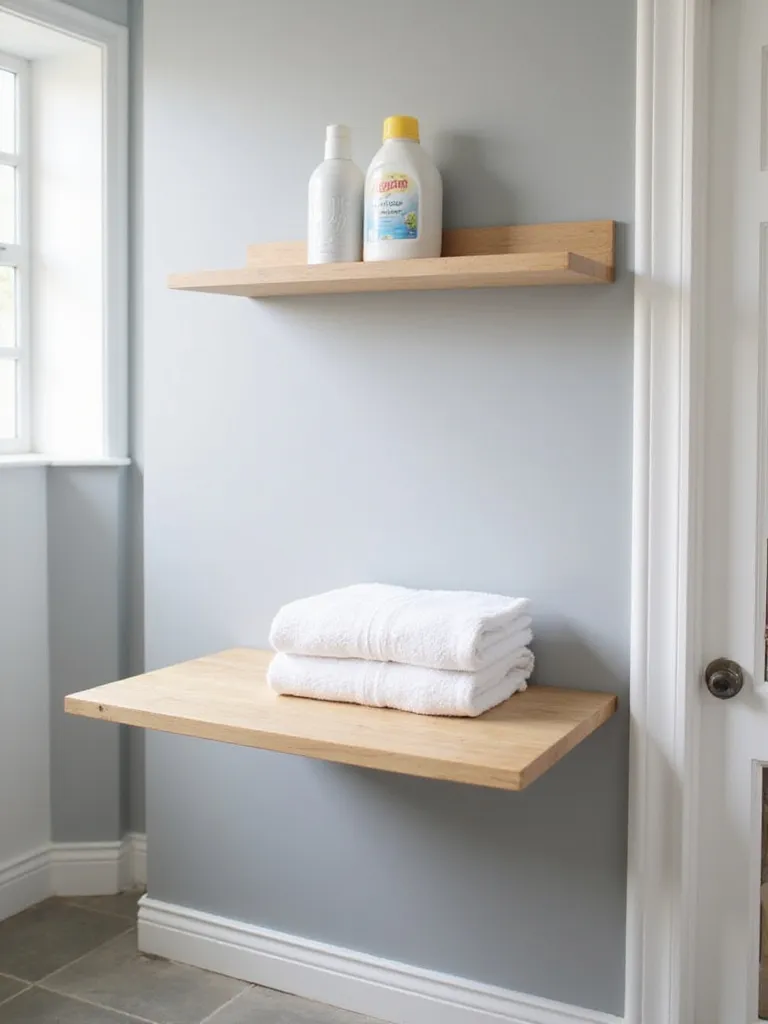
There’s a surprising variety of folding counters available:
The process goes like this: when laundry needs folding, simply pull down your counter, complete your task, then tuck it away when finished. For an extra clever touch, incorporate a built-in ironing board into the folding counter design for a seamless laundry experience.
In the quest for sleek appliances and clever storage, the humble utility sink often gets left out of the laundry room design equation. This oversight misses the immense convenience a dedicated laundry sink provides. Pre-treating stubborn stains, hand-washing delicate garments, soaking heavily soiled items – all become easier and more contained with a utility sink. This prevents dirty tasks from contaminating your food prep or personal hygiene areas, keeping those sinks cleaner and more hygienic.
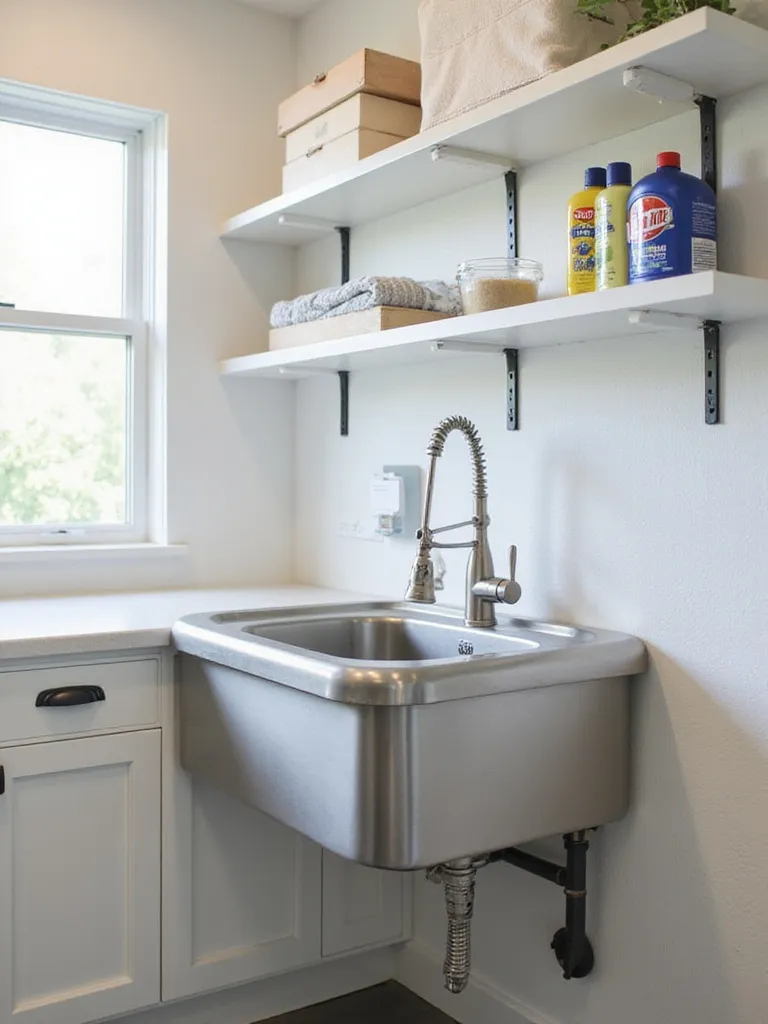
Beyond laundry, a utility sink serves as a workhorse for your home:
The missing piece is often a pull-down faucet with a sprayer for easier rinsing and stain removal. Choose a sink material that’s resistant to stains and chemicals to ensure longevity and easy cleaning – this investment will pay dividends in convenience for years to come.
Imagine trying to sort darks from lights in a dimly lit laundry room, or meticulously pre-treating a stain under harsh, unflattering fluorescent lights. Not exactly inspiring, is it? A single overhead light fixture often casts harsh shadows, making it difficult to see details when sorting, washing, or ironing. Layered lighting solves this problem by combining ambient, task, and accent lighting to provide optimal visibility, reduce eye strain, and significantly enhance the overall feel of the room.
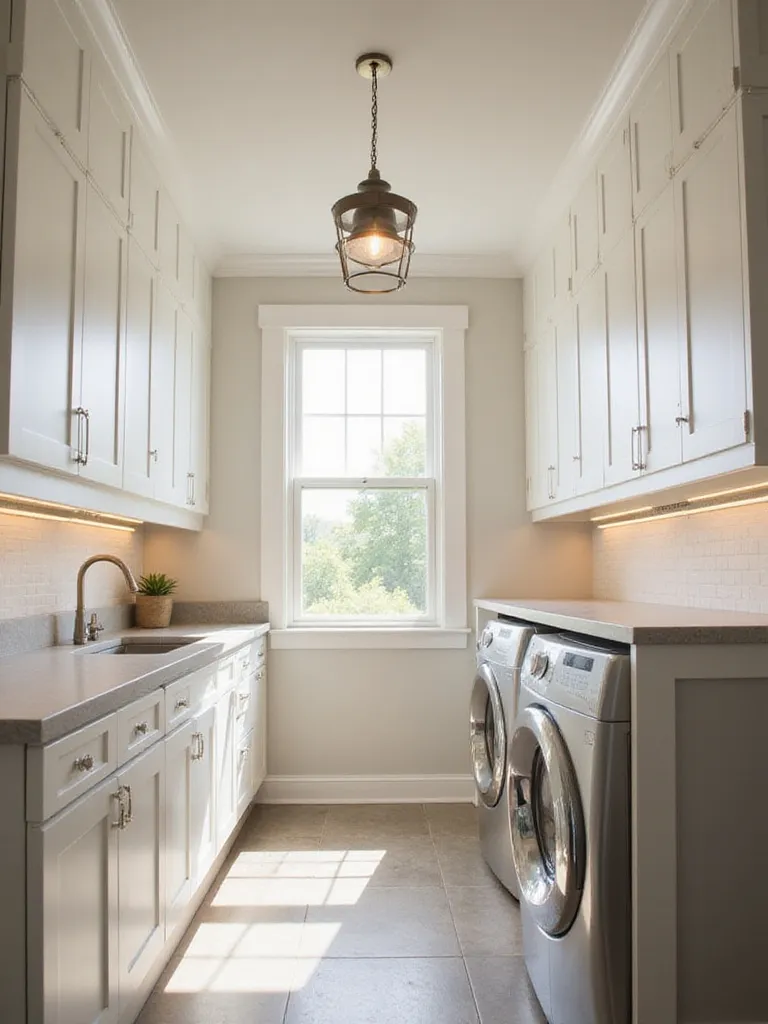
The key thing to understand is that layered lighting involves different types working together:
What really matters here is installing dimmers on all lighting fixtures to adjust brightness based on the task and time of day. The color temperature of light affects mood and productivity – cooler, bluer light works better for task-oriented activities, while warmer, yellower light creates a more relaxing atmosphere.
The laundry room, by its very nature, is a humid environment. Without proper ventilation, this humidity can lead to a host of problems, from unpleasant odors to serious mold issues. This dampness creates the ideal breeding ground for mold and mildew, which not only produce those dreaded musty smells but can also pose significant health risks, particularly for anyone with allergies or respiratory sensitivities.
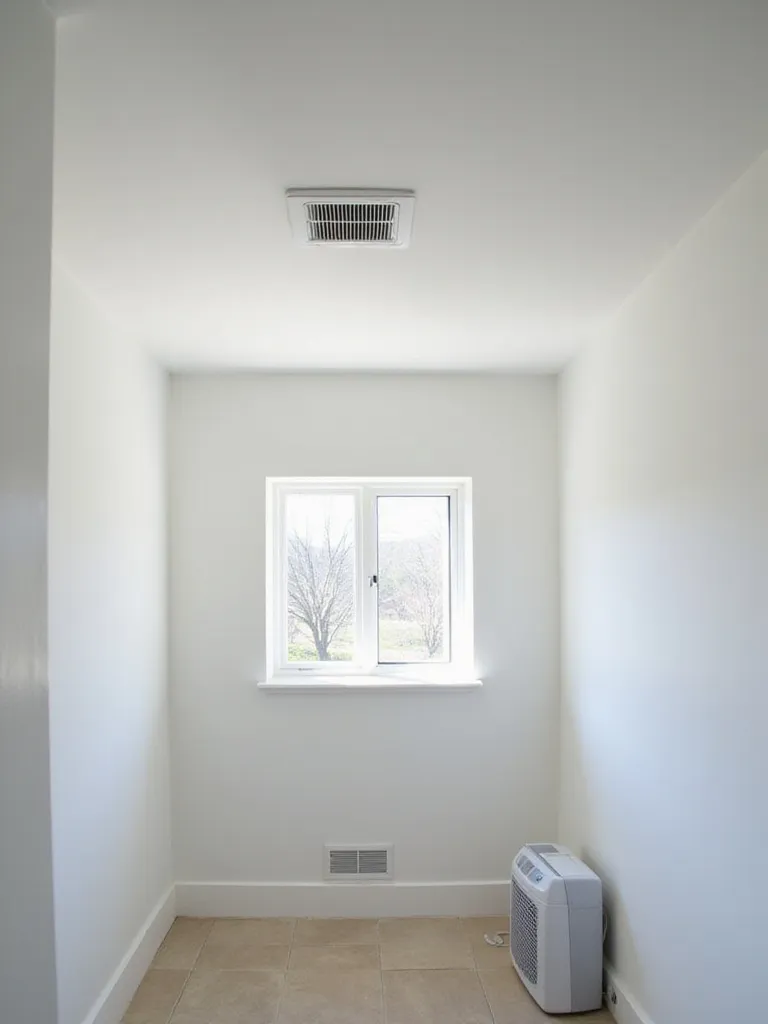
Do you see how huge that is? Here are the telltale signs your laundry room ventilation is lacking:
The stumbling block is often inadequate exhaust systems. Install a powerful exhaust fan vented to the exterior – mold can start growing within 24-48 hours in a moist environment. To test your exhaust fan’s effectiveness, hold a tissue up to it while running. If it’s working properly, the tissue should stick to the fan grill.
Laundry rooms are wet zones. Leaks happen, spills occur, and humidity lingers. Choosing the right flooring is not just about aesthetics; it’s about protecting your home from water damage and ensuring longevity. Water damage can quickly lead to mold growth, warped floors, and costly repairs down the line. Investing in water-resistant or waterproof flooring is a crucial preventative measure that protects your home investment and helps maintain a healthy environment.

Your best flooring options include:
The tricky part is avoiding materials like hardwood and laminate, which are highly susceptible to water damage in a laundry room environment. Before installing any flooring, ensure the subfloor is level, clean, and dry – then consider incorporating a patterned tile floor for a visually appealing and durable surface that enhances your laundry room design.
Laundry day can be a marathon of sorting, washing, drying, folding, and ironing. Why not make it a little more comfortable? Seating provides a dedicated place to sit while tackling tasks like folding clothes, sorting laundry, or simply waiting for a load to finish. This is especially beneficial for anyone with mobility issues or those who simply prefer to sit while working.
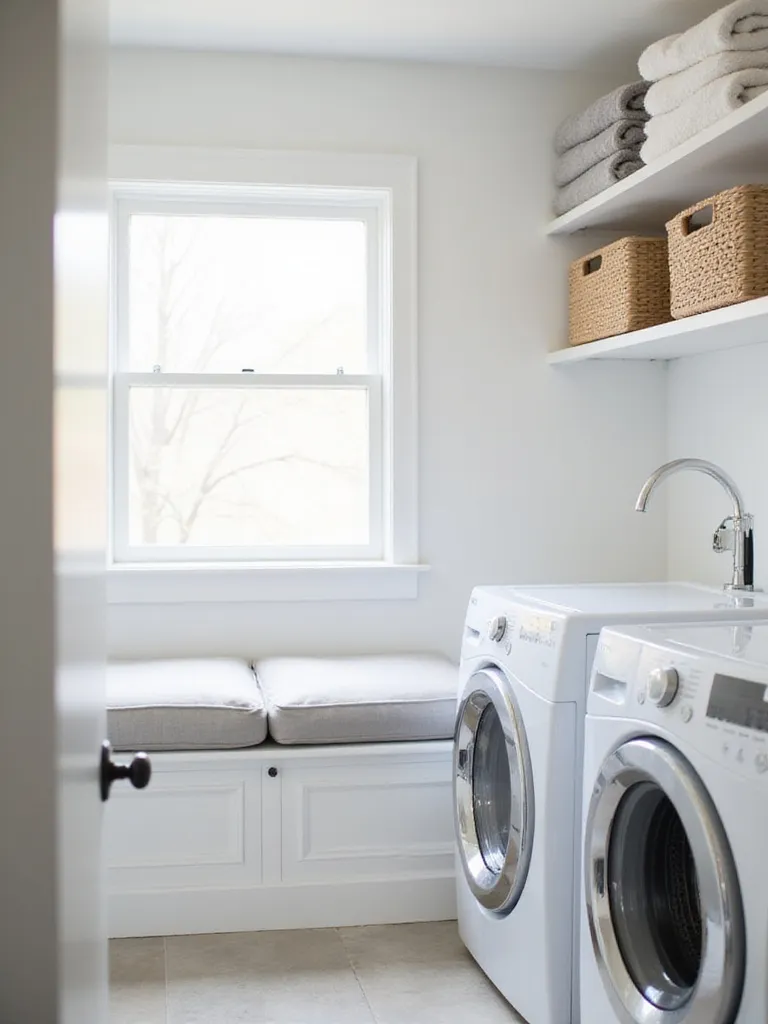
Space is often at a premium in laundry rooms, so consider these smart seating solutions:
My breakthrough came when I installed a custom-built bench with integrated storage for laundry supplies and cleaning products. Historically, laundry was often a social activity, with people gathering to wash clothes together. Seating in modern laundry rooms harkens back to this communal tradition while adding both comfort and functionality to your space.
Who says laundry rooms have to be purely utilitarian and devoid of style? Infusing personality transforms them into more enjoyable and inviting areas, making the chore of laundry feel less burdensome. A well-decorated laundry room elevates the overall aesthetic appeal of your home, reflecting your personal style and attention to detail throughout your living spaces.
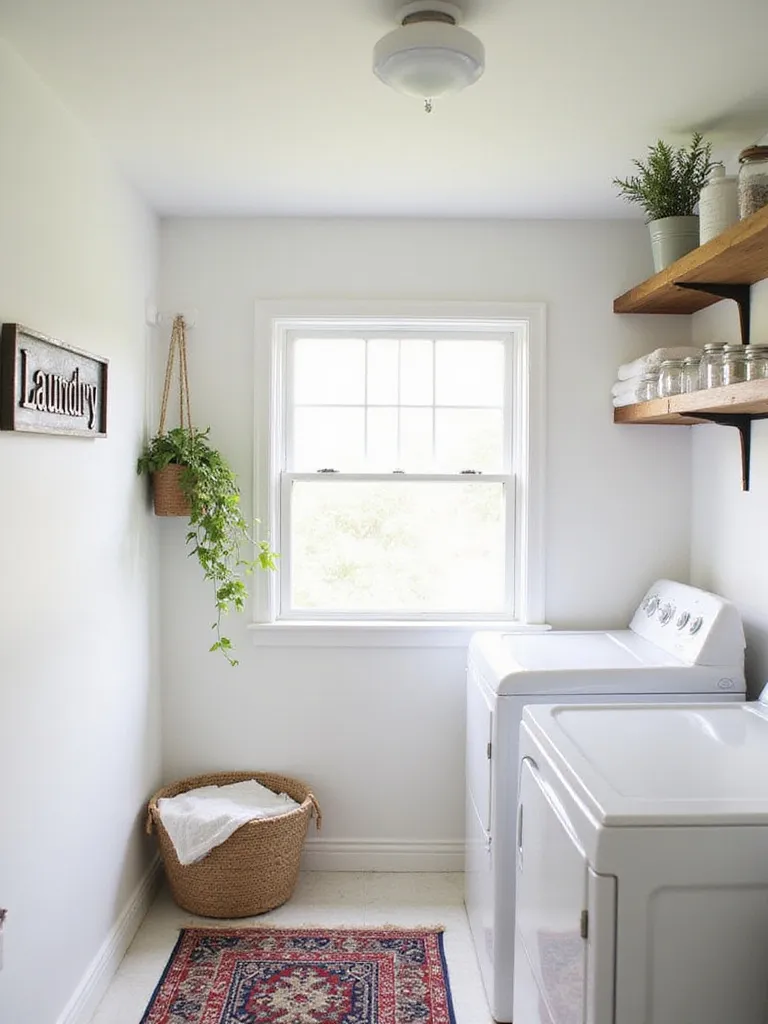
Adding style doesn’t have to break the bank:
“The laundry room is the perfect place to take design risks you might not take elsewhere in your home. Have fun with it!” – Olivia Bennett
Let me paint you a picture: open shelving displaying decorative items like plants, candles, or vintage laundry bottles instantly transforms a utilitarian space into something with character. Create a themed laundry room – vintage, farmhouse, or modern – and select decor that complements that theme for a cohesive and stylish laundry room design.
Openly displayed laundry baskets, especially when overflowing, can instantly make a laundry room feel chaotic and cluttered. Concealing them is a game-changer for creating a more serene and organized space. Hiding them away instantly creates a more functional area, making laundry chores feel less overwhelming. It also contributes to a more streamlined design aesthetic, which is especially important in smaller laundry rooms where every bit of visual calm counts.

Here are several popular methods for concealing laundry baskets:
The heart of the matter is finding a solution that works with your space and lifestyle. Install pull-out hampers within base cabinets, mimicking the look of kitchen drawers. The average household generates approximately 35 pounds of laundry per week, highlighting the need for efficient laundry basket storage that doesn’t dominate your laundry room design.
We touched on vertical storage earlier, but let’s delve deeper into maximizing wall space with a combination of open shelving and closed cabinets. Utilizing vertical space, from floor to ceiling, maximizes your storage potential without sacrificing valuable floor space. This allows you to store everything you need – from detergents and cleaning supplies to ironing boards and laundry baskets – keeping the room tidy and highly functional.

When planning your vertical storage, consider the pros and cons:
Open Shelving:
Closed Cabinets:
The game-changer happened as I combined both in my laundry room design – using open shelving for frequently used items and closed cabinets for things I preferred to keep hidden. The average laundry room is only around 60 square feet, making efficient storage solutions essential for maximizing every inch of available space.
Not everything can or should go into the dryer. A drying rack or rod provides a dedicated space specifically for air-drying delicate clothing items that aren’t suitable for machine drying. Machine drying can cause shrinking, stretching, or damage to delicate fabrics like silk, lace, wool, and items with embellishments. Air drying also extends the lifespan of your clothes and reduces energy consumption.
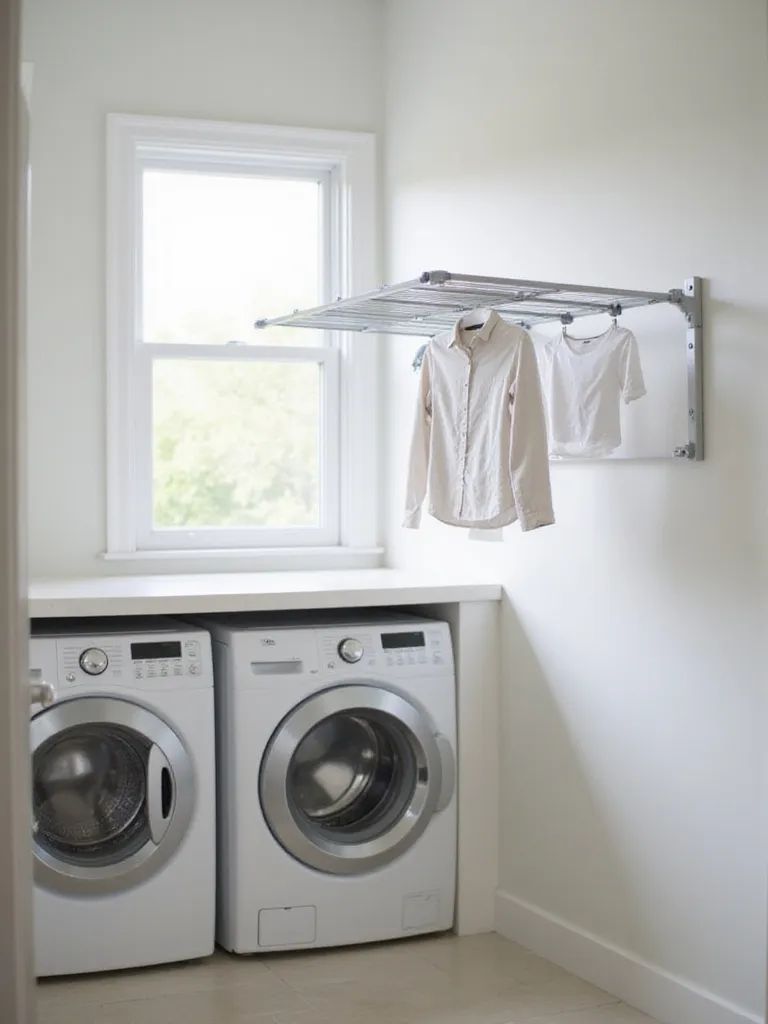
Choose from these drying solutions based on your space:
What complicates this is finding the right balance between functionality and aesthetics. Incorporate a heated drying rack for faster drying and added convenience, especially useful in humid climates. Air drying clothes reduces your carbon footprint by minimizing energy usage – a small change in your laundry routine that benefits both your clothes and the environment.
Ironing boards are notoriously awkward to store. They’re bulky, they lean precariously against walls, and they often end up cluttering valuable floor space. Dedicated storage keeps the ironing board out of sight when not in use, maximizing available space and creating a cleaner, more functional laundry area. It also helps protect the ironing board itself, preventing damage to the board and its cover.
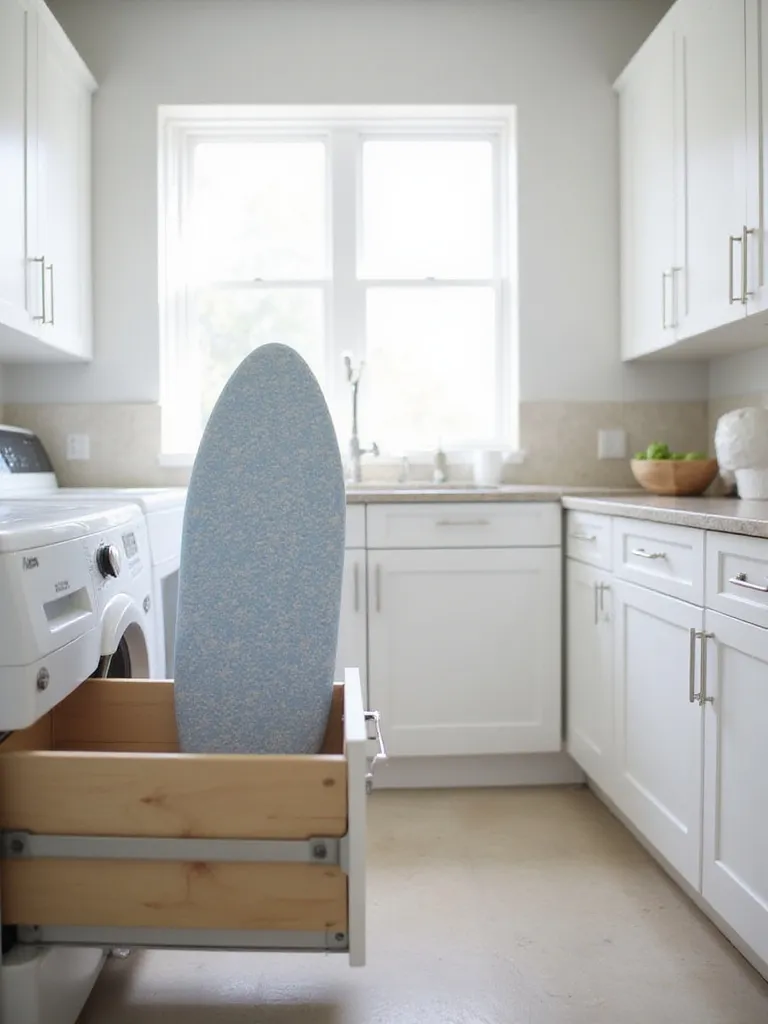
Consider these storage solutions based on your needs:
You might be wondering which option is best for your space. The answer depends on your specific laundry room design and how frequently you iron. A built-in ironing board cabinet integrated into cabinetry offers a seamless look for a polished appearance. Before selecting a storage solution, measure your ironing board (both folded and unfolded) to determine the necessary dimensions.
If you’re a pet owner, incorporating pet-friendly features into your laundry room can be a wonderful way to integrate your furry companions into your home design. It provides a dedicated, out-of-the-way area for your pet’s needs, keeping their belongings organized and contained within one space, and preventing them from spreading throughout the rest of your home.
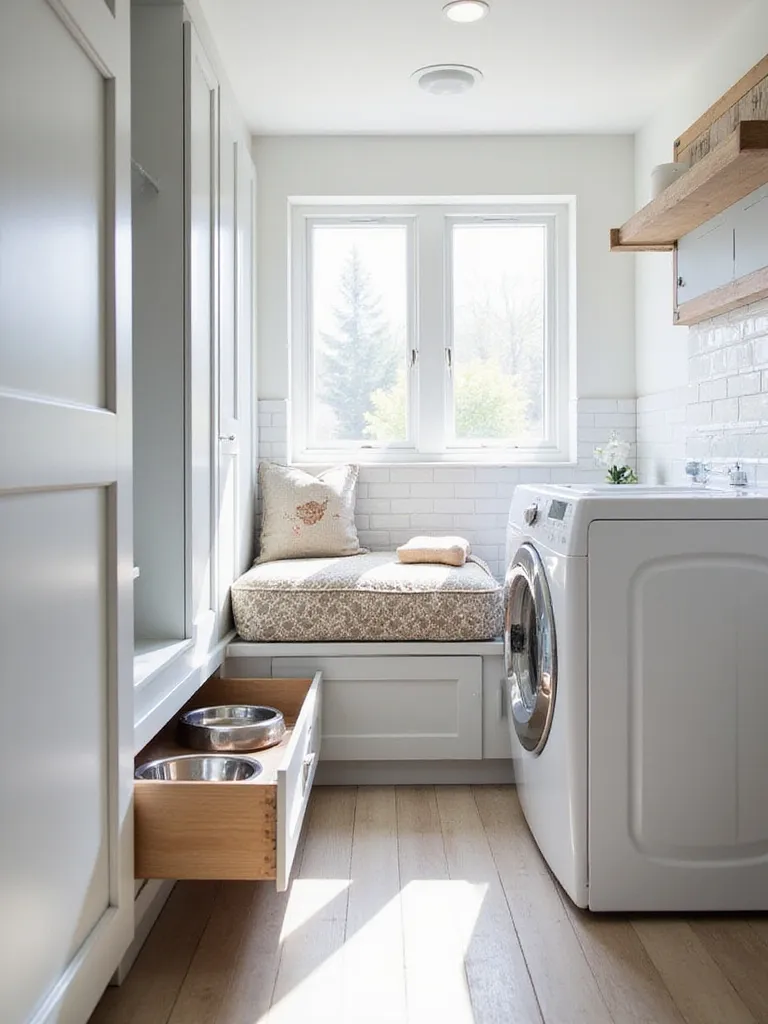
When designing pet-friendly features, consider these factors:
Things took an interesting turn when I utilized the space under the laundry room cabinets to create a cozy, recessed pet bed in my own laundry room design. Many pets find the sound of the washing machine soothing, making the laundry room a potential calming space for them – a win-win for both you and your furry friends.
Washing machines and dryers, while essential, can be noisy appliances. If your laundry room is near living spaces or bedrooms, soundproofing can significantly improve the peace and quiet in your home. Laundry appliances can generate a significant amount of noise while operating, which can be disruptive to other areas of your home, particularly if the laundry room is located near bedrooms, living rooms, or home offices.
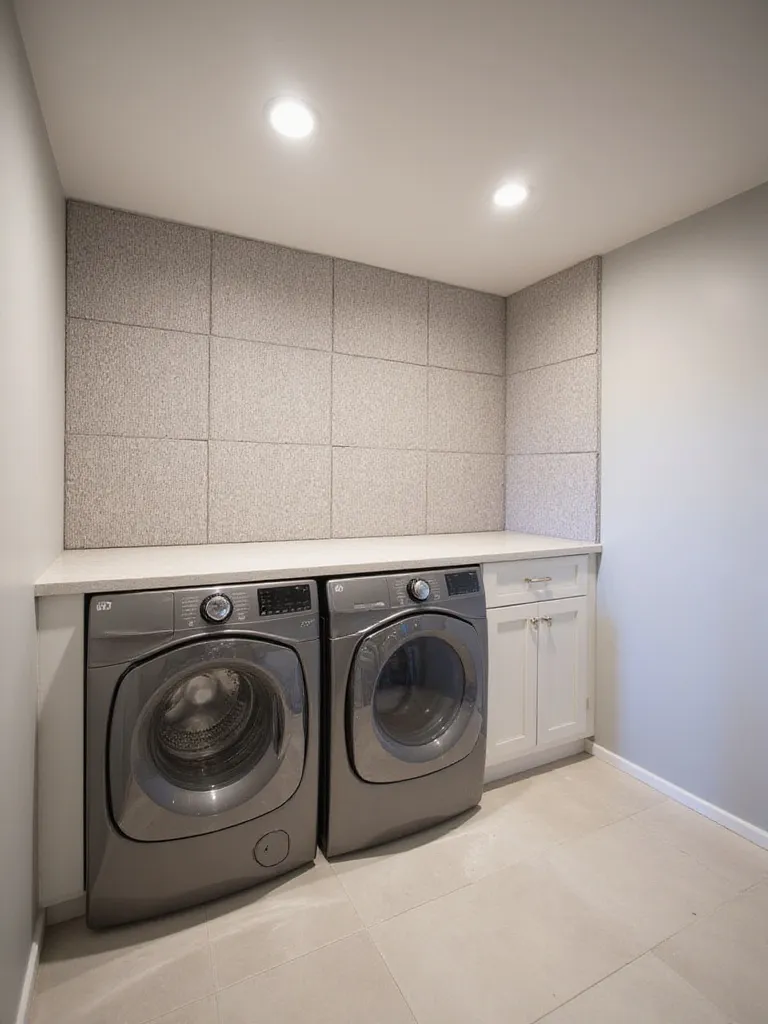
The primary sources of laundry room noise include:
The breakthrough came when I created a ‘soundproof cocoon’ by enclosing laundry appliances within a custom-built cabinet lined with acoustic foam. The decibel level of a washing machine during its spin cycle can reach up to 75 dB, comparable to the noise of a vacuum cleaner. Apply acoustic sealant around the laundry room door frame and install a door sweep to minimize sound leakage through gaps for a quieter home environment.
Natural light is a mood booster and a practical asset in any room, and the laundry room is no exception. Natural light offers superior illumination compared to artificial light, making it easier to sort clothes, spot stains, and fold laundry with greater clarity. Sunlight also has natural disinfecting properties, helping to reduce mold and mildew growth, which is particularly beneficial in a space often exposed to moisture.

The best window options for a laundry room include:
Now, I know what you’re thinking – “What if my laundry room doesn’t have windows?” Install a solar tube in a windowless laundry room to channel sunlight from the roof. Sunlight contains UV rays that can naturally disinfect fabrics, helping to eliminate odors and kill bacteria. Consider the orientation of your room when planning window placement in your laundry room design – south-facing windows receive the most sunlight throughout the day.
Color psychology plays a significant role in how we perceive and feel in a space. Bright, airy colors can make the space feel larger and more inviting, making you more inclined to spend time there. Conversely, dark or drab colors can make the room feel cramped and depressing, making laundry feel even more like a chore.

Popular and effective color palettes for laundry rooms include:
“Blue is the perfect choice for laundry rooms – it psychologically connects to cleanliness while creating a calm environment for what can be a tedious chore.” – Olivia Bennett
The surprising part is how much color can transform the entire laundry experience. Paint the walls a calming light blue and add pops of yellow with accessories like laundry baskets and towels. Before committing to a color, test paint samples on a small area of the wall and observe how the color looks under different lighting conditions throughout the day.
Smart technology is revolutionizing homes, and the laundry room is no exception. Smart technology offers a range of benefits, including remote control of appliances, automated detergent dispensing, customized wash cycles, energy consumption tracking, and seamless integration with smart home ecosystems for voice control and automated notifications.
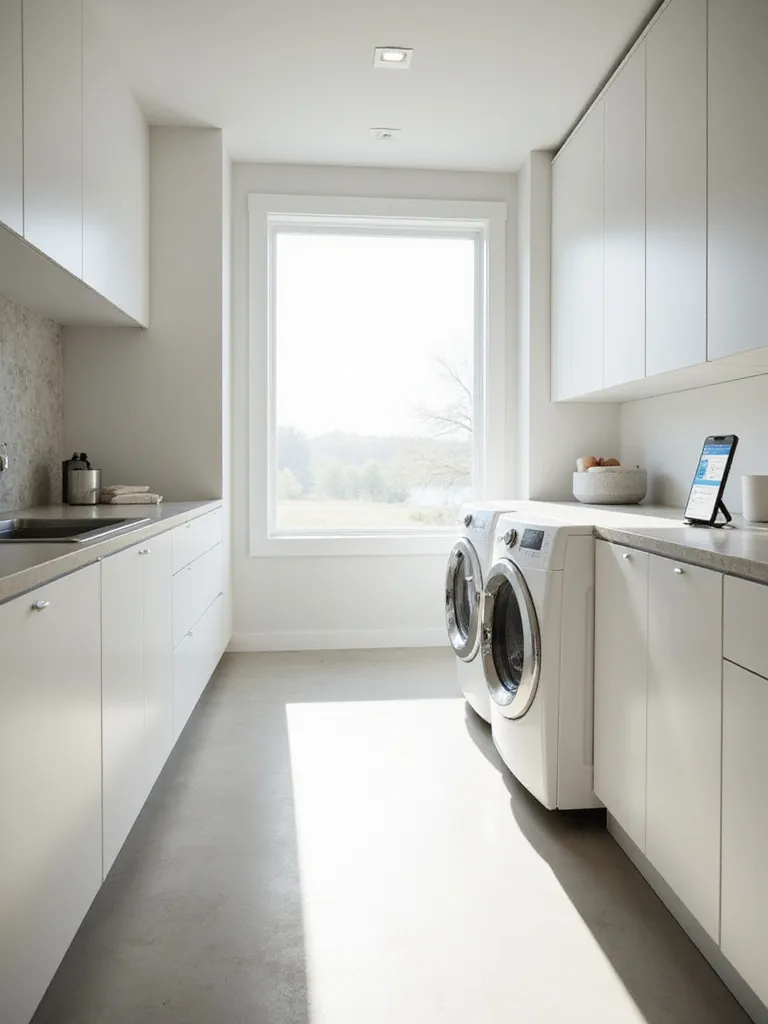
Smart appliances transforming laundry rooms today include:
The potential here is enormous! Utilize a smart washing machine with automatic detergent dispensing to eliminate the guesswork and mess of manual dosing. Start by upgrading your washing machine and dryer to smart models with Wi-Fi connectivity and app control. Look for features like automatic detergent dispensing and customized wash cycles to create a truly modern laundry room design.
The laundry room, often a busy thoroughfare in the home, can be the perfect spot to create a family command center. Because everyone in the household visits the laundry room regularly, it increases the likelihood that important information posted in a command center will actually be seen and utilized by all family members. Furthermore, utilizing otherwise unused wall space in the laundry room is a smart way to maximize functionality.

Essential elements of a functional family command center include:
Picture it this way: incorporate a key holder or hooks near the entrance to the laundry room for easy access. Studies show that families who use a shared calendar are more likely to attend important events and appointments. Start by assessing your family’s needs and identifying the most important elements to include in your command center to make it truly functional for your household.
In today’s gadget-filled world, sufficient electrical outlets in the laundry room are not just a convenience; they are a necessity for safety and functionality. Insufficient outlets can lead to blown fuses, tripped breakers, and even pose a fire hazard. Furthermore, having dedicated circuits for high-power appliances like dryers is often a code requirement for safety.
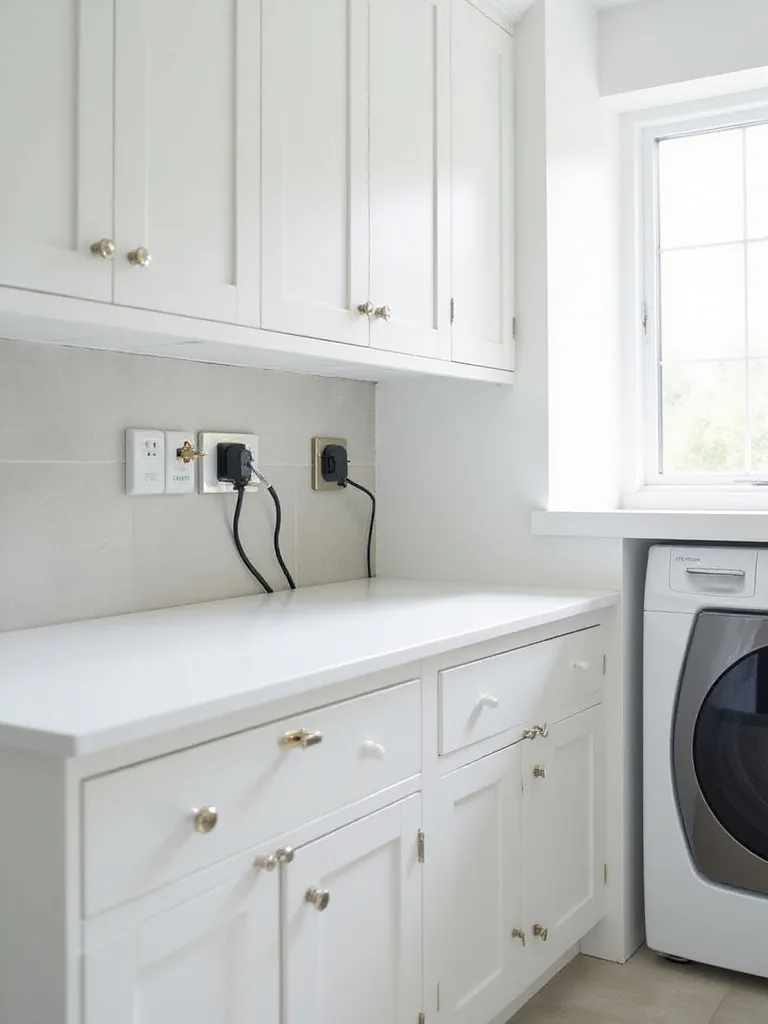
The ideal number of outlets depends on your specific needs, but generally include:
Let me show you another perspective: think about future-proofing your laundry room design – what new appliances or smart features might you want to add down the line? Install USB charging ports within the outlets to conveniently charge handheld vacuums, phones, or other devices. Consult with a qualified electrician to assess your laundry room’s electrical needs and ensure proper wiring and outlet installation.
Transforming your laundry room from a drab, purely functional space into an organized, stylish, and even enjoyable area is absolutely achievable with these genius design ideas. From maximizing vertical space and incorporating smart storage solutions to adding personal touches with color and décor, each idea contributes to a more efficient and pleasant laundry experience.
By implementing even a few of these transformations, you can say goodbye to laundry room dread and hello to a space that simplifies your chores and enhances your home. So, are you ready to turn your laundry room into a true haven of fresh-smelling, folded perfection? Start planning your transformation today and discover the joy of laundry day, redefined.